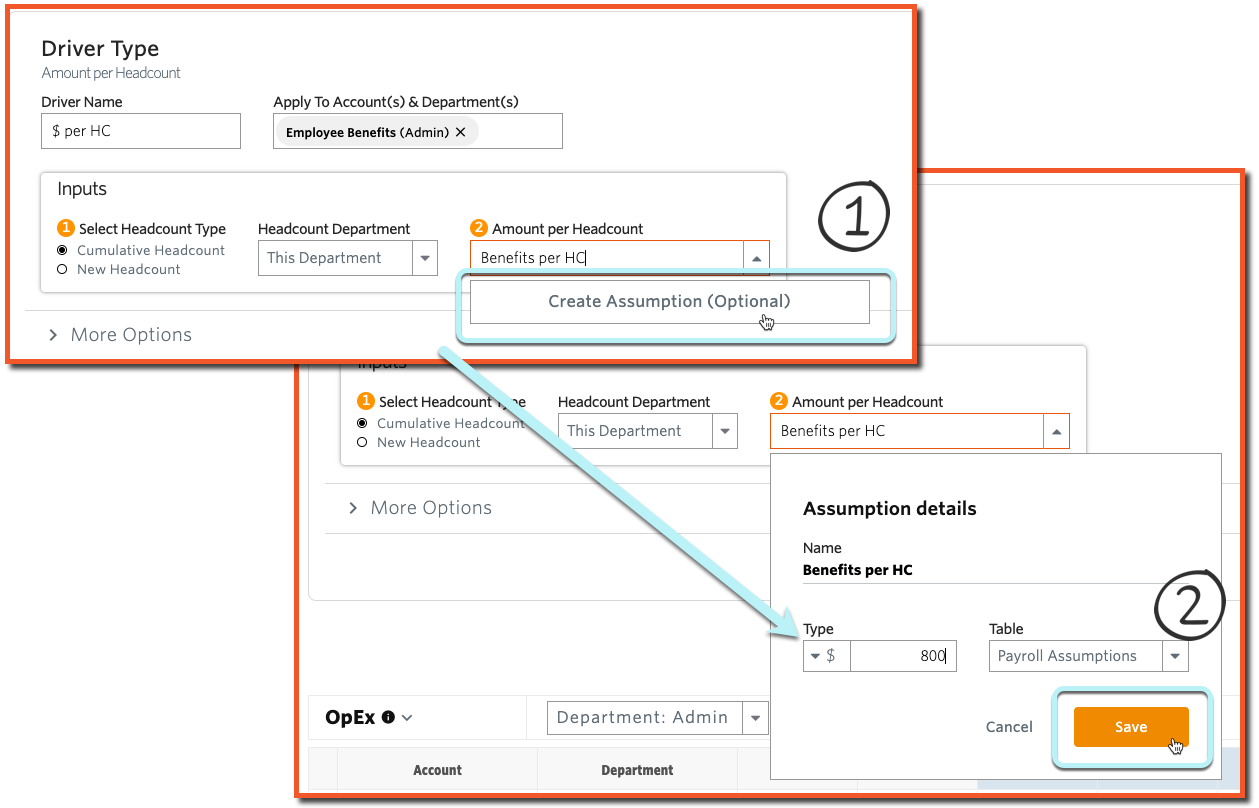Utilize Assumptions, Drivers & Subitems to create a meaningful operating expense plan
When thinking about planning for operating expenses, we can generally categorize them into 2 categories, variable and fixed. A variable expense will fluctuate with the growth of the company, e.g., commissions will increase as revenue increases. Whereas a fixed expense remains the same regardless of company performance, e.g., monthly rent is a constant amount for the entire term of the lease.
Use a combination of Drivers, Assumptions & Subitems to model variable & fixed operating expenses in Jirav.
Driver Overview
Drivers utilize logical formulaic expressions to predict future planning periods. For example, use a driver to forecast office supplies using a 3-month trailing average of actuals plus 5% annual growth for inflation.
To add drivers to the planning tables, access the driver library, which includes the most commonly used methods for planning operating expenses.-
- Annual Target: Input as an Annual Amount that reallocates based on YTD actuals for the remainder of the year
- Fixed Spread: Input as an Annual Amount that does NOT reallocate based on YTD actuals
- Growth on Historicals: Forecasts the future using the historical annual growth rate (requires 2 years of actuals)
- Periodic Growth: Grows the base value periodically either by a % or $ amount
- $ per Headcount
- % of Another Account
- Custom

Helpful Hints:
- A combination of multiple drivers, subitems, and direct input can be used for the same account, everything in Jirav is additive in nature.
- Reference assumptions in the drivers to quickly update the forecast.
- Optionally edit the start or end date for a driver, the frequency the driver calculates, or round the calculated output.
- Clone the same driver to multiple accounts & departments.
Assumption Overview
Assumptions represent key variables for your company that can be referenced throughout your plans via drivers. For example, to plan employee benefits as a $ per headcount, create $ per headcount as an assumption. Then, the driver will multiply the $ per headcount assumption by headcount.
Helpful Hint:
Creating variables as assumptions in Jirav is a best practice as they provide an identifiable summary of all assumptions made in the model that can easily be reviewed and modified.
When adding standard drivers, follow the prompts to create the variable as an assumption or select a previously created assumption.

To modify the value of the assumption after it is created, select the assumptions icon on the right side of the screen.

Did you know?
If you click on an assumption value, any accounts that are referencing that particular assumption will be highlighted in yellow in the planning table that you are viewing.
Go to Settings > Assumptions to create assumptions for use in custom drivers, rename or reorder or delete existing assumptions and create new or delete existing assumption tables.
Subitem Overview
Subitems allow for more detailed planning of an account by inputting values to specific months with a text description. Subitems can be used in conjunction with Drivers to plan for an account. For instance, a subitem can be used to budget for a particular vendor or consultant with sporadic payments.
Subitems are added from the department level within a planning table.


Helpful Hints:
- Subitems are unique to their respective departments and cannot be seen by other departments. For example, a subitem added to the Admin department would not be visible in the Sales department.
- Subitems allow for fixed amounts to be entered, but cannot have drivers attached to them. Drivers can only be attached at the account or custom line level.
Additional Resources: Plan Drivers, Standard Drivers
